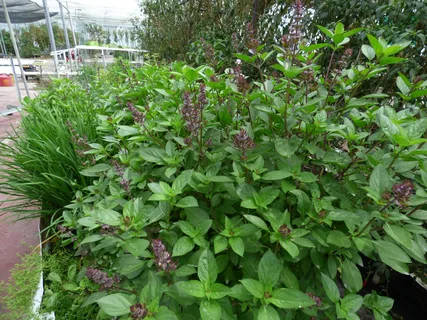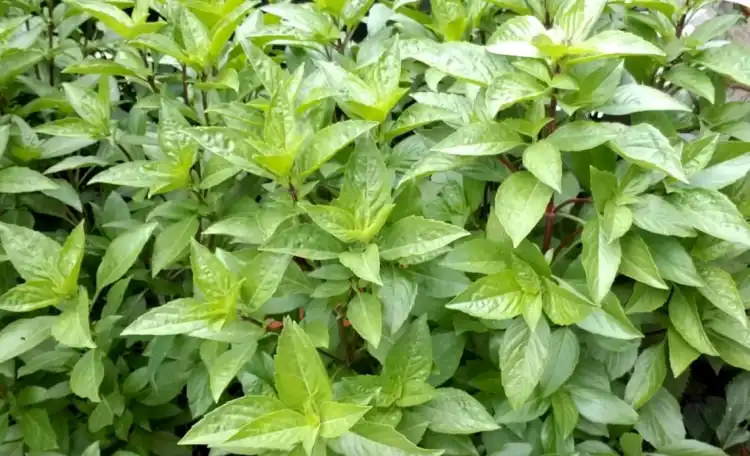Understanding Thai Basil
Thai basil is a cultivar of sweet basil (Ocimum basilicum) native to Southeast Asia, particularly Thailand. It is prized for its distinctive flavor, which is slightly spicy and peppery with notes of licorice and mint. Thai basil features narrow, pointed leaves and purple stems, making it an attractive addition to both culinary dishes and ornamental gardens.

Selecting a Growing Location
Outdoor Cultivation
Choose a sunny location for outdoor cultivation, as Thai basil thrives in full sun.
Ensure the soil is well-draining and rich in organic matter, with a pH level between 6.0 and 7.5.
Plant Thai basil in raised beds, containers, or directly in the ground, providing adequate spacing between plants to promote airflow and prevent overcrowding.
Indoor Cultivation
Select a sunny windowsill or a location with access to at least 6-8 hours of sunlight per day for indoor cultivation.
Use well-draining potting soil with added perlite or vermiculite to improve drainage and aeration.
Consider supplementing natural sunlight with grow lights to ensure sufficient light intensity for optimal growth.
lanting Thai Basil
Seeds
- Start Thai basil seeds indoors 6-8 weeks before the last frost date in your area.
- Sow the seeds 1/4 inch deep in seed-starting trays or small pots filled with moist potting soil.
- Keep the soil consistently moist and maintain a temperature of around 70-75°F (21-24°C) for germination.
Transplants
- If using transplants, wait until after the last frost date to plant them outdoors or transfer them to larger containers indoors.
- Dig a hole slightly larger than the root ball of the transplant and gently loosen the roots before planting.
- Water the transplants thoroughly after planting to help them establish quickly in their new environment.
Care and Maintenance
Watering
- Keep the soil evenly moist but not waterlogged, as Thai basil prefers slightly moist conditions.
- Water the plants at the base to avoid wetting the foliage, which can increase the risk of fungal diseases.
Fertilization
- Apply a balanced fertilizer or compost tea every 4-6 weeks during the growing season to provide essential nutrients.
- Avoid over-fertilizing, as excessive nitrogen can result in lush foliage but poor flavor development.
Pruning
- Pinch off the growing tips of Thai basil plants regularly to encourage bushy growth and prevent flowering.
- Harvest leaves frequently to promote continuous growth and prevent the plants from becoming leggy.
Harvesting Thai Basil
- Harvest Thai basil leaves as needed once the plants reach a height of 6-8 inches.
- Use clean scissors or pruning shears to snip off individual leaves or cut entire stems from the plant.
- Avoid harvesting more than one-third of the plant at a time to allow it to continue growing and producing new foliage.
Pests and Diseases
- Monitor Thai basil plants regularly for signs of common pests such as aphids, whiteflies, and spider mites.
- Control pest infestations with natural remedies such as neem oil, insecticidal soap, or companion planting with pest-repelling herbs.
- Prevent fungal diseases such as powdery mildew by providing adequate airflow, avoiding overhead watering, and applying fungicidal sprays as needed.
Conclusion
In conclusion, growing Thai basil is a rewarding endeavor that allows you to enjoy the fresh flavors and aromatic qualities of this versatile herb. By following the steps outlined in this expert guide, you can cultivate healthy and productive Thai basil plants in your garden or indoor space. Whether used in Thai cuisine, herbal teas, or decorative arrangements, Thai basil is sure to add a touch of exotic flair to your culinary and gardening adventures.
What is Thai Basil, and how does it differ from other basil varieties?
Thai Basil (Ocimum basilicum var. thyrsiflora) is a cultivar of sweet basil native to Southeast Asia. It differs from other basil varieties in its distinct flavor profile, which includes notes of licorice, mint, and spice, making it a staple in Thai, Vietnamese, and other Southeast Asian cuisines.
Where should I plant Thai Basil?
Thai Basil thrives in full sun, so it’s best to plant it in a location that receives at least 6-8 hours of sunlight per day. Ensure the soil is well-draining and rich in organic matter, with a slightly acidic to neutral pH level.
Can I grow Thai Basil indoors?
Yes, Thai Basil can be grown indoors, provided it receives sufficient sunlight. Place potted Thai Basil plants near a sunny window or use grow lights to supplement natural sunlight. Use well-draining potting soil and ensure adequate airflow to prevent fungal diseases.
When should I plant Thai Basil seeds?
Thai Basil seeds can be started indoors 6-8 weeks before the last frost date in your area. Sow the seeds 1/4 inch deep in seed-starting trays or small pots filled with moist potting soil. Keep the soil consistently moist and maintain a temperature of around 70-75°F (21-24°C) for germination.
How often should I water Thai Basil plants?
Thai Basil prefers slightly moist soil, so water the plants whenever the top inch of soil feels dry to the touch. Avoid overwatering, as waterlogged soil can lead to root rot and other fungal diseases. Water at the base of the plants to keep the foliage dry and reduce the risk of disease.
Do Thai Basil plants need fertilizer?
Thai Basil plants benefit from regular fertilization to promote healthy growth and abundant foliage. Apply a balanced fertilizer or compost tea every 4-6 weeks during the growing season to provide essential nutrients. Avoid over-fertilizing, as excessive nitrogen can result in lush foliage but poor flavor development.
How do I harvest Thai Basil leaves?
Thai Basil leaves can be harvested as needed once the plants reach a height of 6-8 inches. Use clean scissors or pruning shears to snip off individual leaves or cut entire stems from the plant. Avoid harvesting more than one-third of the plant at a time to allow it to continue growing and producing new foliage.
How can I prevent pests and diseases in my Thai Basil plants?
Monitor Thai Basil plants regularly for signs of common pests such as aphids, whiteflies, and spider mites. Control pest infestations with natural remedies such as neem oil, insecticidal soap, or companion planting with pest-repelling herbs. Prevent fungal diseases such as powdery mildew by providing adequate airflow, avoiding overhead watering, and applying fungicidal sprays as needed.
Can I propagate Thai Basil from cuttings?
Yes, Thai Basil can be propagated from cuttings taken from mature plants. Simply snip off a 4-6 inch stem from the parent plant, remove the lower leaves, and place the cutting in a glass of water or moist potting soil. Keep the cutting in a warm, sunny location and ensure the soil stays moist until roots develop.
How long does it take for Thai Basil to mature?
Thai Basil typically matures in about 60-75 days from planting, depending on growing conditions and climate. However, you can begin harvesting leaves once the plants reach a height of 6-8 inches, allowing for continuous harvesting throughout the growing season.
- Tennessee’s THC Beverage Market - June 5, 2025
- Top THC Infused Seltzers in Delaware - June 5, 2025
- Florida’s Hottest THC Infused Beverages - May 28, 2025




